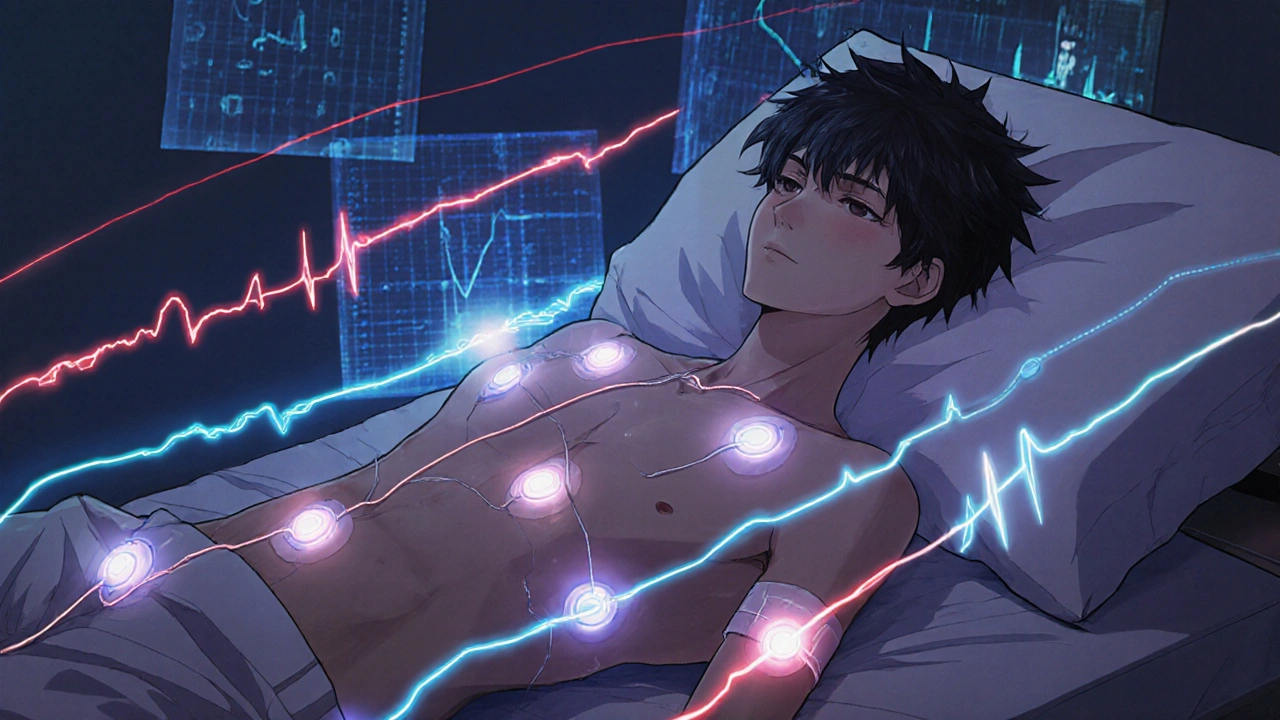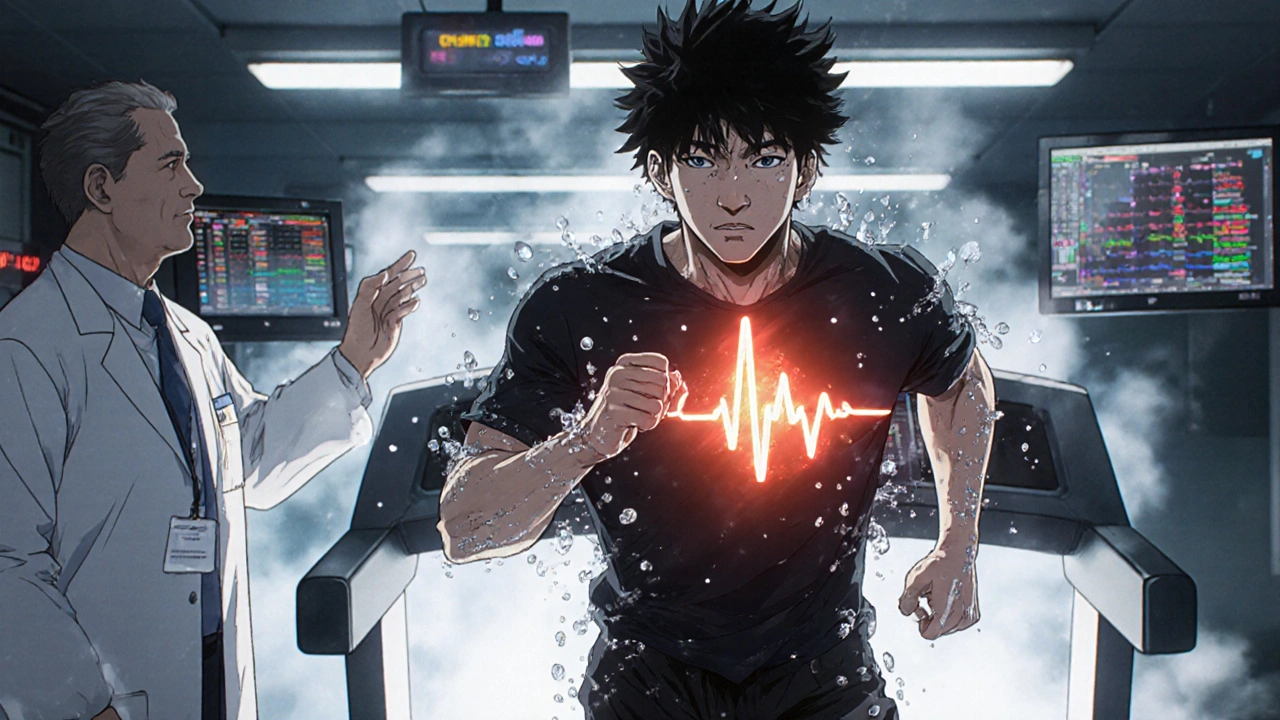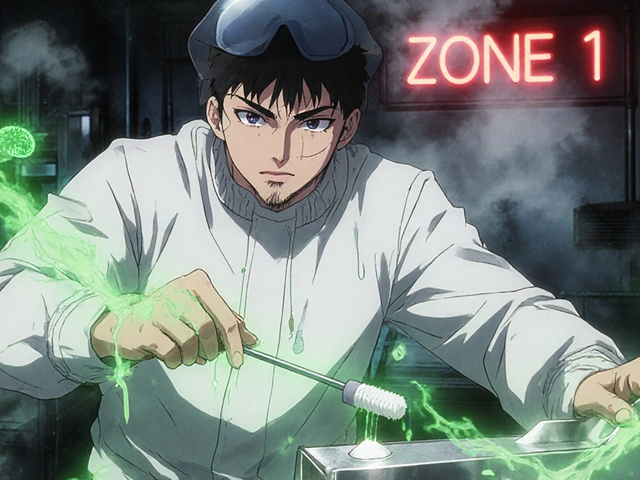
When your doctor says you need an ECG or a stress test, it’s not because they’re being overly cautious. It’s because they’re looking for answers your body can’t give out loud. These tests don’t require needles, cuts, or hospital stays-but they can catch problems other checks miss. If you’ve ever felt your heart race for no reason, gotten winded climbing stairs, or had chest tightness during exercise, these tests might be the key to understanding what’s really going on.
What an ECG Actually Measures
An ECG, or electrocardiogram, is a quick snapshot of your heart’s electrical activity. It’s not a picture of your heart’s structure-it shows how electricity moves through it. That’s important because your heartbeat is controlled by electrical signals. When those signals get messy, your heart can beat too fast, too slow, or irregularly.During the test, ten small sticky pads are placed on your chest, arms, and legs. These don’t send electricity into you-they just record what your heart is already doing. The whole thing takes about five minutes. You lie still, breathe normally, and that’s it. No pain. No discomfort. Just a flat line turning into waves on a screen.
Doctors look for patterns in those waves. A flat line where there should be a peak? That could mean a past heart attack. A zigzag instead of a smooth rhythm? That might be atrial fibrillation. A slow dip in the ST segment? That’s often a sign your heart isn’t getting enough blood-especially if it shows up during stress.
Here’s the catch: a resting ECG can miss problems that only show up when your heart is working hard. That’s why many people need more than just this basic test.
Why Stress Tests Are Different
A stress test pushes your heart to work harder-usually by walking on a treadmill or pedaling a stationary bike. The goal? To see how your heart handles pressure. When you’re at rest, your heart might look perfectly normal. But under stress, blocked arteries can’t deliver enough blood, and that’s when trouble shows up.The most common version is the exercise stress test, often using the Bruce protocol. It starts slow-1.7 miles per hour with a 10% incline-and gets tougher every three minutes. Speed and slope increase until you’re out of breath, dizzy, or your heart hits 85% of its maximum (which is roughly 220 minus your age). If you can’t exercise due to arthritis, asthma, or other issues, doctors use chemicals like adenosine to mimic exercise by widening your blood vessels and making your heart beat faster.
During the test, they monitor four things: your heart rate, blood pressure, ECG pattern, and oxygen levels. If your ECG shows new ST-segment drops, or your blood pressure crashes, or you start having chest pain, the test stops. These aren’t just symptoms-they’re warning signs.
Studies show that for detecting blocked arteries, a standard exercise stress test catches about 68% of cases. That’s decent, but not perfect. That’s why some people get upgraded versions.
Stress Echo vs. Nuclear Stress: What’s the Difference?
Not all stress tests are the same. Two advanced types add imaging to the mix:- Stress echocardiogram: Uses ultrasound to take pictures of your heart before and after stress. If a part of the heart muscle doesn’t move as well after exercise, it likely means that area isn’t getting enough blood. This test has no radiation and is especially good at spotting problems in women.
- Nuclear stress test: Involves injecting a tiny amount of radioactive dye and using a special camera to see how well blood flows through your heart. It’s more sensitive-catching about 85% of blockages-but you’re exposed to radiation equivalent to 3-4 years of natural background exposure.
Cost matters too. A nuclear stress test averages around $946. A stress echo runs about $514. A CT scan of your heart? Around $404. But price doesn’t always mean better. For middle-aged women with symptoms but no obvious blockages, stress echo is now the top recommendation from the American College of Cardiology because it avoids radiation and gives clearer results.

Who Needs These Tests-and Who Doesn’t
These tests aren’t for everyone. The American College of Cardiology says they’re most useful for people with a 15% to 65% chance of having coronary artery disease. That usually means you have symptoms like chest pain during activity, or risk factors like high blood pressure, diabetes, smoking, or a family history of early heart disease.If you’re young, healthy, and symptom-free, you don’t need a stress test just because you’re worried. If you’ve had a recent heart attack, unstable angina, or severe heart failure, stress tests can be dangerous and are avoided.
Women face unique challenges. Studies show ECG stress tests miss up to 40% of heart problems in premenopausal women. Why? Their symptoms are often different-fatigue, nausea, jaw pain instead of crushing chest pain. Their arteries may be smaller or have microvascular disease, where tiny vessels get blocked, not the big ones. Stress echo helps here because it sees actual muscle movement, not just electrical changes.
And if you’re over 65 with no symptoms? Routine stress testing isn’t recommended unless you’re planning major surgery or have new symptoms. Screening healthy people doesn’t save lives-it just leads to more tests, more anxiety, and sometimes unnecessary procedures.
What to Expect Before, During, and After
Preparation is simple but important:- Avoid caffeine for 24 hours before the test-it interferes with chemical stress agents.
- Don’t eat a heavy meal two hours before.
- Wear comfortable clothes and walking shoes.
- Bring a list of your medications-some may need to be paused.
During the test, you’ll feel your heart pounding. That’s normal. With chemical stress, you might feel flushed, short of breath, or have a metallic taste in your mouth. Some people panic because it feels like a heart attack. But the staff is trained. They know what’s happening. The feeling lasts less than a minute.
Afterward, you can usually drive yourself home. No recovery time. No restrictions. Results? Many clinics give you a preliminary read before you leave. A full report from a cardiologist takes a few days.

Common Problems and False Results
No test is perfect. About 18% of ECGs during stress tests get messed up by movement or poor electrode contact. In 12% of chemical stress tests, the heart doesn’t reach the target rate, making the results unclear. And in one out of four intermediate-risk patients, the test comes back inconclusive-meaning you’ll need another test.False positives happen too. Someone might have an abnormal ECG but no blockages. That leads to more tests-like a cardiac catheterization-that carry their own risks. False negatives are even more dangerous. A woman with microvascular disease might get a clean result, then have a heart attack months later.
This is why doctors don’t rely on one test alone. They look at your symptoms, your risk factors, your family history, and your ECG pattern together. A single abnormal wave doesn’t mean you need a stent. A completely normal test doesn’t mean you’re risk-free.
The Future of Heart Testing
Technology is changing how we read these tests. Artificial intelligence is now being used to analyze ECG patterns with 18-22% more accuracy than human doctors. Portable devices like the Cardiac Dynamics StressPal can now do full stress tests in a doctor’s office, a nursing home, or even a gym-without a full lab setup.At Stanford, researchers are combining stress echo with speckle-tracking technology to detect subtle muscle strain in women with microvascular disease. This method boosts sensitivity from 68% to 89%. That’s huge.
As CT scans get cheaper and faster, they may replace stress tests for low-risk patients. But for now, stress testing remains the go-to tool for evaluating symptoms and guiding treatment. It’s not flashy. It doesn’t involve lasers or robots. But it’s proven, practical, and saves lives every day.
What Your Results Mean
A normal result doesn’t mean you’re heart-healthy forever. It just means your heart handled the test well. If you’re overweight, smoke, or have high cholesterol, you still need to manage those risks.An abnormal result doesn’t mean you’re having a heart attack tomorrow. It means you have a problem that needs attention-maybe lifestyle changes, medication, or further testing.
The real value of these tests isn’t in the numbers. It’s in the clarity they bring. If you’ve been ignoring chest tightness or breathlessness, a stress test can give you permission to take your health seriously. And that’s worth more than any machine can measure.
Can an ECG detect a heart attack?
Yes, an ECG can show signs of a past or current heart attack. It detects changes in the electrical pattern caused by damaged heart muscle. If you’ve had chest pain and your ECG shows ST-segment elevation or abnormal Q waves, that’s a strong indicator of heart muscle injury. But not all heart attacks show up on ECG-especially if they’re small or happened a while ago. That’s why doctors combine ECG results with blood tests for heart enzymes and other imaging.
Is a stress test safe?
Yes, stress tests are very safe when done under medical supervision. Serious complications like heart attack or dangerous arrhythmias are rare-less than 1 in 1,000 tests. The staff is trained to stop the test immediately if anything looks wrong. Chemical stress tests carry slightly higher risk than exercise tests, but side effects like flushing or dizziness are common and temporary. If you have unstable heart conditions, your doctor will avoid stress testing altogether.
Why do I need to avoid caffeine before a stress test?
Caffeine blocks the same receptors that drugs like adenosine use to simulate exercise. If you’ve had coffee, tea, soda, or chocolate in the last 24 hours, those drugs won’t work properly. That means your heart won’t respond the way it should, and the test results could be inaccurate. Even decaf coffee can contain enough caffeine to interfere. It’s not a suggestion-it’s a requirement for a valid test.
Can stress tests detect blocked arteries?
Yes, but not directly. Stress tests detect how your heart responds when it’s under demand. If blood flow is restricted by blockages, your heart muscle won’t get enough oxygen during exercise. That causes changes on the ECG, abnormal movement on echo images, or reduced blood flow on nuclear scans. While they don’t show the blockage itself, they show its effect-making them excellent tools for identifying coronary artery disease.
Are stress tests accurate for women?
Standard ECG stress tests are less accurate for women, especially younger women. They often have microvascular disease-blockages in small arteries-that doesn’t show up on traditional ECGs. Women also experience different symptoms, like fatigue or nausea, rather than classic chest pain. Stress echocardiography is far more reliable for women because it sees actual heart muscle function, not just electrical signals. For this reason, current guidelines now recommend stress echo over standard stress tests for women with symptoms and intermediate risk.
Write a comment
Your email address will not be published.





10 Comments
This article is literally life-saving info-but why is no one talking about how often these tests are pushed on people who don’t need them? I had a stress test last year because my doctor was ‘just being safe’-turns out I was fine, but now I’ve got a $2,000 bill and a whole new anxiety disorder.
Let’s be real: if you’re a woman over 40 and you’ve ever felt ‘off’ during a workout, you’ve probably been gaslit by a cardiologist who thinks your symptoms are ‘just stress.’ The fact that stress echo is more accurate for women but still underused? That’s not medical negligence-it’s systemic bias dressed up as protocol.
I got the nuclear test. Felt weird. Got a little dizzy. The guy said it was normal. Then I Googled radiation and now I’m scared I’m gonna glow in the dark. Why do they even do this? I just wanted to know why I get winded walking to the fridge.
Excellent and comprehensive overview. 🙏 For individuals with microvascular dysfunction, especially in South Asian populations where metabolic syndrome is prevalent, stress echocardiography remains the gold standard. The absence of radiation and superior sensitivity to regional wall motion abnormalities makes it ideal for early detection. Always consult with a cardiologist who specializes in women's heart health.
YOU CAN DO THIS. Seriously. If you're nervous about a stress test, remember: you're not alone. I was terrified too-but the staff was so calm and kind. They checked on me every minute. And guess what? I got a clean bill of health. Now I walk 5 miles a day and feel better than I have in years. Your heart is strong. Trust the process.
It’s fascinating how the article mentions AI improving ECG interpretation by 18-22%, but doesn’t delve into the ethical implications-like algorithmic bias in training datasets that predominantly use male cardiac data, or how automated systems might overlook atypical presentations in women, elderly, or non-Caucasian patients. Also, the cost disparity between nuclear stress tests and stress echo raises questions about healthcare equity, especially since insurance coverage varies wildly by region and provider. And while portable devices like the StressPal sound revolutionary, how accessible are they in rural areas or for uninsured populations? Are we just creating a two-tiered system where tech-savvy urban patients get superior diagnostics while others rely on outdated protocols? And what about long-term data privacy with these digital ECGs being stored in cloud systems? There’s so much more beneath the surface than the article lets on.
Yeah right. Another feel-good medical article written by someone who’s never had to pay for one of these tests. My insurance denied my stress echo because it was 'not medically necessary'-but when I had a heart attack three months later, they covered the stent. Classic.
why do people still trust doctors?? i had a stress test and they said i was fine but i still felt like crap. then i went to a naturopath and she said my adrenal glands were fried from sugar and stress. guess who was right? the guy with the crystals and the herbal tea. also caffeine? pfft. i drink 5 espressos a day and i'm fine. your body knows what it needs.
This was so helpful! I’ve been ignoring my chest tightness for months because I thought it was just anxiety. Now I’m scheduling my stress echo. Thank you for explaining the difference between ECG and echo so clearly. 💙 Also-yes to avoiding caffeine! I didn’t know decaf could interfere. Learned something new today.
As an American, I find it appalling that we’re still using 1970s-era protocols for cardiac screening while countries like Germany and Japan have integrated AI-driven diagnostics into routine care. The fact that we’re still debating whether to use nuclear scans over echo tests in 2025 is a national embarrassment. We have the technology. We have the data. We just lack the will. And that’s not medical-it’s moral failure.